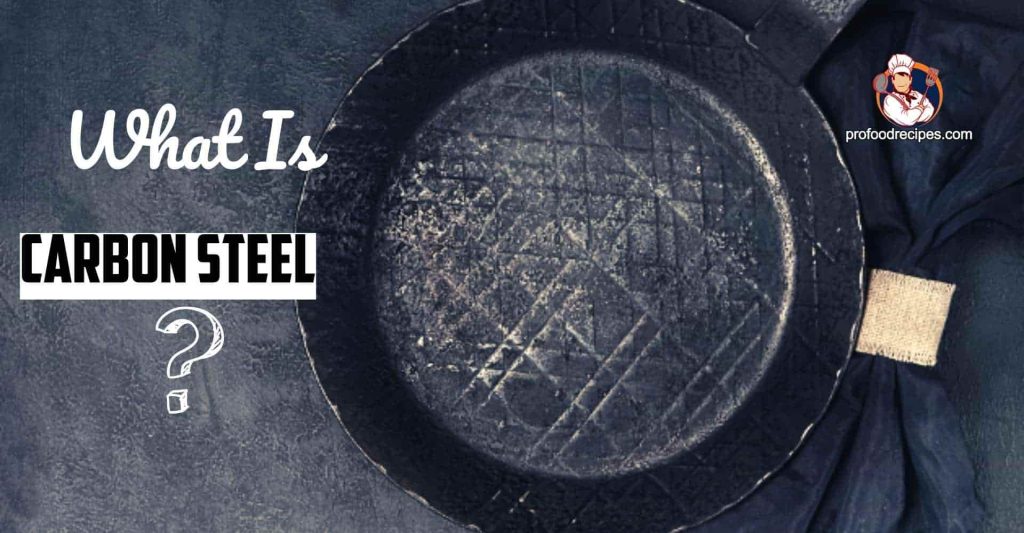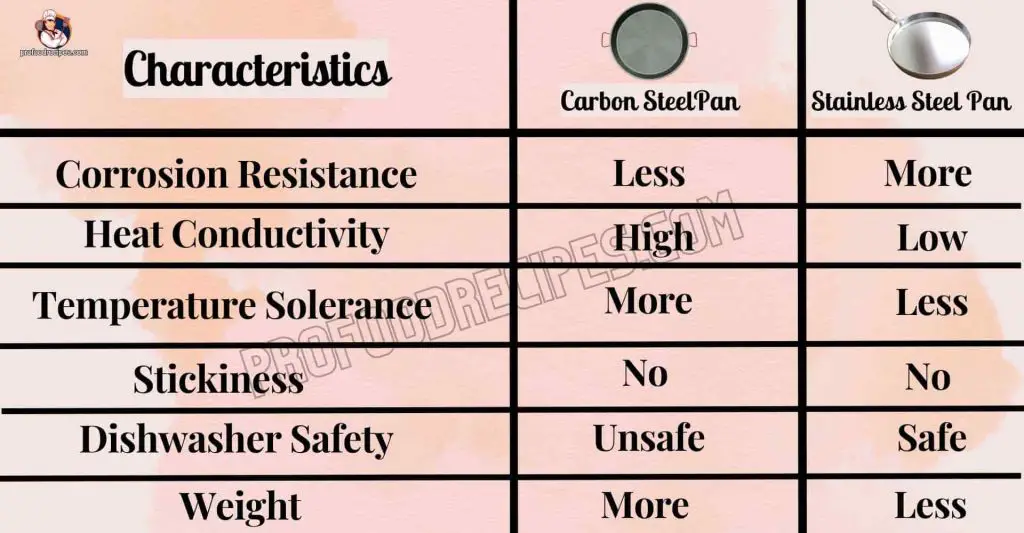Last Updated on January 13, 2023 by Amanda P. Brown
Carbon steel and stainless steel pans are the go-to materials for chefs in the culinary industry. Both are in high demand and widely recognized because of their high-quality characteristics, including longevity, impermeability, lightweight, and inertness to chemical reactions.
Despite having the same name, they differ greatly in terms of the materials they are made of and the unique attributes they offer. However, this article includes their purposes, features, what they are, and Carbon Steel vs. Stainless steel Pan. This information may help you pick the most appropriate one from these two best pans according to your kitchen demand.
What is Carbon Steel?
Table of Contents

One of the brilliant alloy composition-based steels, carbon steel, is primarily made of iron and carbon. The mixed alloy is strengthened by adding additional materials like silicon, copper, and other elements.
They are more enduring and heat-tolerant due to their entire constitution. Although some varieties of steel contain iron, they are not particularly heavy. You can, therefore, swiftly stir them during cooking times.
Features of Carbon Steel
Due to its extraordinary qualities, carbon steel is now widely used in kitchens everywhere, from households to restaurants. Among its wonderful qualities are the following:
- Extreme hardness
- More durability
- High strength
- Resistance to wear
- Moderate ductility
- High heat tolerance
- Lightweight (so easy to stir)
Pros and Cons of Carbon Steel Pans
Carbon steel cookware is a staple in commercial and home kitchens alike. This cookware is well-known for its superior cooking results. However, let’s have a look at the benefits and drawbacks of using carbon steel cookware:
Pros of Carbon Steel
- Quick Heat up
- High heat tolerance
- ResponsiveSuitable for all types of stoves or heating elements.
- Safe
- Easy to maneuver (as its weight is light)
- Durable
- Affordable
- Versatile use
Cons of Carbon Steel
- Reactive to acidic foods
- Requires seasoning (otherwise, food sticks)
- Hot handles
- In dishwasher –unsafe
- Heat distribution- Uneven
- Susceptible to oxidizing and discoloration (if it doesn’t get proper care and maintenance.)
What is Stainless Steel?

Stainless steel is mainly iron and carbon alloy based on other elements like chromium, carbon, iron, and other alloying components. Its wonderful composition provides exceptional services.
To further enhance mechanical qualities and avoid corrosion, adding other elements like molybdenum, niobium, nickel, titanium, etc., is highly recommended. Its ability to remain watertight for longer makes it superior to nonstick pans made of other materials.
Features of Stainless Steel
Stainless steel cookware is equally long-lasting as carbon steel. Additionally, it offers various unique amenities because of its high-quality components. Stainless steel can be a reliable companion for household use. These are some of the key features:
- Durable but lightweight
- High ductile strength
- Waterproof (not easily react with normal pure water, but if the water contains more salt elements, then it may lose its feature and easily corrode)
- Temperature resistant
- Less rusted
- Easy formability
- Long lasted and low-maintenance.
- Attractive appearance
Pros and Cons of Stainless Steel Pans
Cookware made from stainless steel is highly regarded because of its numerous desirable qualities. In any case, just like every other material, stainless steel has its benefits and drawbacks. Below are the benefits and drawbacks included.
Pros of Stainless Steel
- Durable and long-lasting
- Smooth surface
- Cooks evenly (as heat distribution is even)
- Non-reactive to certain foods
- Heat retains good
- Easy to clean and maintenance
- Generally dishwasher safe
- Shiny, polished, and attractive appearance
- Highly resistant to rust and corrosion
- Recyclable material
Cons of Stainless Steel
- Heat conductor – poor (not best)
- Susceptible to scratching
- Discoloration
- Expensive
- Require seasoning first
- Can’t cook without oil as nonstick pans, you can do
Read More:
Carbon Steel Vs. Stainless Steel Pans – Major Differences

Both carbon steel and stainless steel cooking pans are the most durable, lightweight, and well-known, and they can perform adequately. They are distinct from one another, with the metal used in production as a clue to their differences. Listed below are some additional key distinctions that will aid you in visualizing the benefits and drawbacks of these two cookware sets.
1. Corrosion Resistance
Despite being stronger and more resilient than stainless steel, carbon steel is more quickly subject to rust or corrosion than stainless steel, particularly when in contact with moisture. (But blue carbon steel can withstand more defense corrosion than other common ones.)
2. Heat Conductivity
Stainless steel has a low heat conductivity because it lacks copper alloy or other metallic components that can improve it. Users aren’t adversely affected any more than usual, though. Carbon steel, however, has become more well-known in this context. They have high thermal conductivity.
3. Temperature Solerance
Compared to stainless steel, carbon steel has a greater capacity to withstand high temperatures. Extremely high temperatures might damage the bottom pan of stainless steel.
4. Stickiness
There is no equal performer between the two in terms of nonstick pans. Nonetheless, carbon steel could be useful in reducing food stickiness. However, you can get better results from either type of pan if you spray it with a nonstick coating.
5. Dishwasher Safety
Dishwashers are unsafe for carbon steel, so you’ll need to hand wash any carbon steel cookware, but stainless steel may go in without worry.
6. Weight
Carbon steel and stainless steel have similar weights, but aluminum is significantly lighter; therefore, stainless steel frying pans are often easier to handle than their carbon steel counterparts of comparable dimensions.
7. Versatility
Both are able to provide you with the identical services for preparing various kinds of dishes. But Carbon steel is suitable for stir-frying and stainless offers excellent sautéing. They are both oven-safe cookware and perform brilliantly on induction cooktops.
What is the Best Purpose of Carbon Steel Used?
Carbon steel is the most durable and efficient metal. It has versatile use, such as cooking vessels, cutting tools (like chisels), blades, hot water radiators, metal lamp posts, large machine parts, and industrial castings.
However, the kitchen is one of the most frequent places you’ll find carbon steel. Even in commercial kitchens, carbon steel is the material for everyday cooking. Chefs are becoming fond of it due to its ability to withstand high temperatures and simultaneously cook large quantities of food.
What is the Best Purpose of Stainless Steel Used?
Stainless steel, an alloy of nickel and chromium, has excellent thermal stability. This explains why it’s so common in superheaters, heat exchangers, boilers, valves, feed water heaters, and even mainstream lines.
Furthermore, sautéing food is the most common and ideal use for stainless steel. A stainless steel pan can be a wonderful helper for you in the kitchen daily.
Which is a Healthier Option, Carbon Steel or Stainless Steel?
Cookware made of carbon steel and stainless steel is equally secure. Carbon steel has a natural nonstick coating, so if you season it well, you can use less butter or oil when cooking. Additionally, this is a perfectly nutritious alternative. More importantly, neither one has any potentially dangerous Teflon coating.
Even with a smooth exterior, they still don’t react to food. However, it is not safe to use metal or non-metal cookware that has rusted. Since carbon steel is extremely vulnerable to oxidation and discoloration, you need to keep maintenance. You can trust the safety of your food in any pan because of its durability and strength.
Carbon Vs. Stainless Steel, Pan-which is Better?
Both carbon steel and stainless steel have become widely used because of their superior qualities. Good-clad stainless steel will do the trick if you need a pan that can be used for a variety of things and is adaptable to varying temperatures. As an alternative, carbon steel is the best material to use if you need a pan for deep frying, high-heat searing, and keeping food warm.
Final Verdict
Each home appliance’s capabilities, benefits, and drawbacks are unique. Therefore, you should determine which one can be modified to meet your needs. I hope the information above about Carbon Steel vs. Stainless steel pan will help you to know the key differences between the two, as well as the benefits and drawbacks of each, and will help you make an informed decision.
You May Also Like to Read:
- Wok VS Frying Pan – Which One to Use?
- How to Cook With Stainless Steel Cookware?
- How to Care for Stainless Steel Cookware?
- Is Non Stick Cookware Safe?
- 10-Tips for How to Clean Copper Cookware

